Some history of the “glory days” with Bald Eagles at Farmington Bay Waterfowl Management Area and some thoughts on what potentially happened to those days.
As part of my long-time summer job with the Utah Museum of Natural History I used to visit Farmington Bay often back in the 70’s and 80’s. But when I finally decided I could take summers off and only teach full-time the refuge and I no longer crossed paths and that estrangement lasted for almost 20 years. When I took up bird photography in 2007 my very good friend Deedee Obrien (we had worked together at the museum years before) reintroduced me to Farmington. She had “connections” at the refuge and was able to take me through the gates to areas most folks can’t visit during breeding season (or any other time for that matter) and for me it was love at first sight. It was loaded with birds and it was much closer to my home in Salt Lake City than Bear River MBR which was my usual bird hangout back in those very early days.
Some months later when I experienced my first winter on the refuge with the Bald Eagles I was literally blown away!
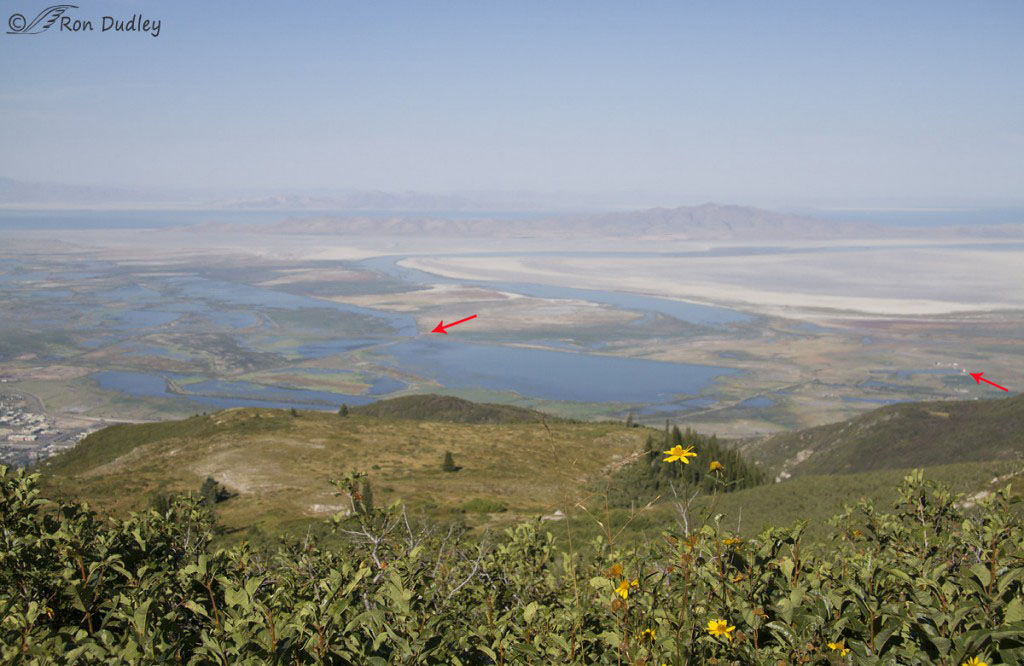
First lets become better acquainted with Farmington Bay WMA from afar. Unlike the rest of these images this photo was taken in summer and from near the top of the Wasatch Mountains (as I was approaching the top of Bountiful Peak) just to the east of the refuge. Most of the water and wetland expanse we see below is part of the refuge with Antelope Island (no longer a true island) in the middle background with other mountains barely seen on the far horizon to the left.
For locals, and for regular blog readers who may recognize the names, the red arrow on the right marks what many call the “Golf Ball”, a distinctive landmark which is actually an FAA radar installation right next to Glover pond that can be seen adjacent to it.
The red arrow in the middle marks the location of what most of us call the “4-way pond” where many of the following photos were taken. The actual pond is small and hidden by vegetation growing around it so it can’t be seen in this view. Unit 1, which you’re about to become familiar with, is the very large pond below and to the right of that arrow.
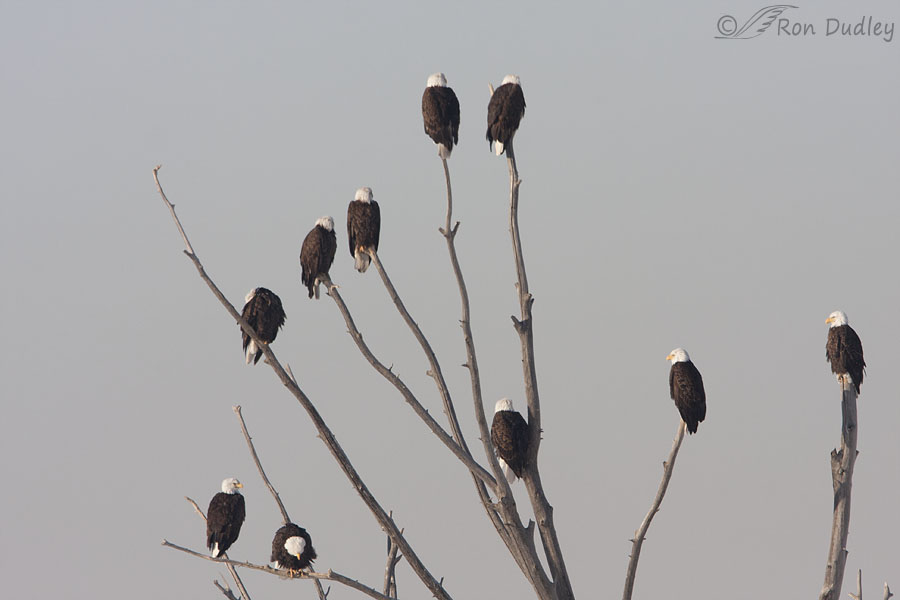
This is the sight that used to get hearts pounding soon after photographers entered the refuge – Farmington’s iconic “Eagle Tree”. It’s an old, dead snag that was often so full of eagles that at times it seemed to be more bird than wood. Usually all you could get was butt shots from the far-away road because the eagles were always looking the other way toward all the birds on the water of Unit 1 of the refuge.
Sadly, all that remains of this snag is a single, seriously leaning trunk – the rest of it is almost horizontal or actually on the ground.
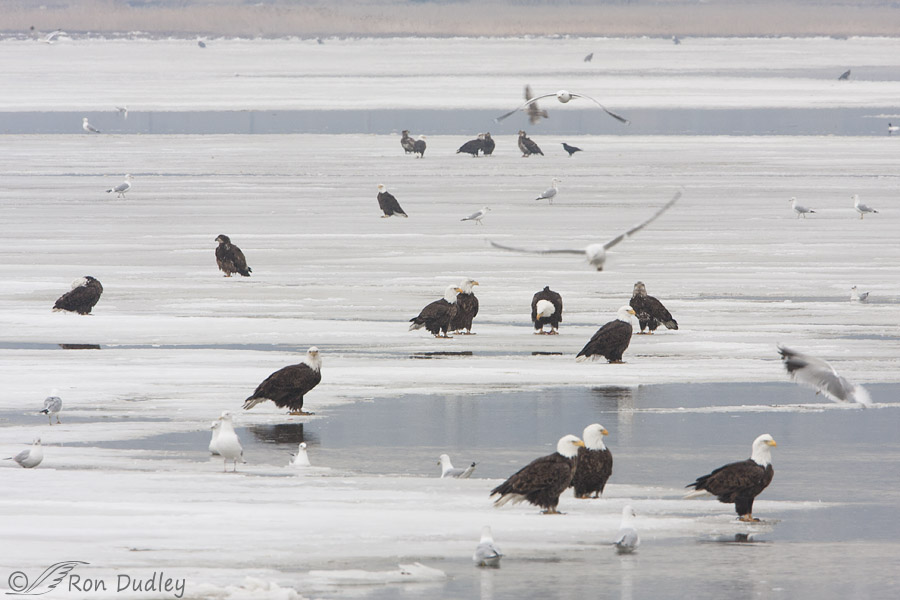
Back in those days this was a fairly typical view from the road heading to the 4-way looking out over the ice on Unit 1 – more eagles than you could shake a monster lens at. I count a minimum of 23 eagles in this narrow view taken at an effective 1120 mm with my 500 mm lens and attached teleconverter. That’s a very narrow slice of Unit I and there were many more eagles out of frame to both the left and right.
Often there were hundreds of them on the refuge but most years they concentrated on Unit 1.
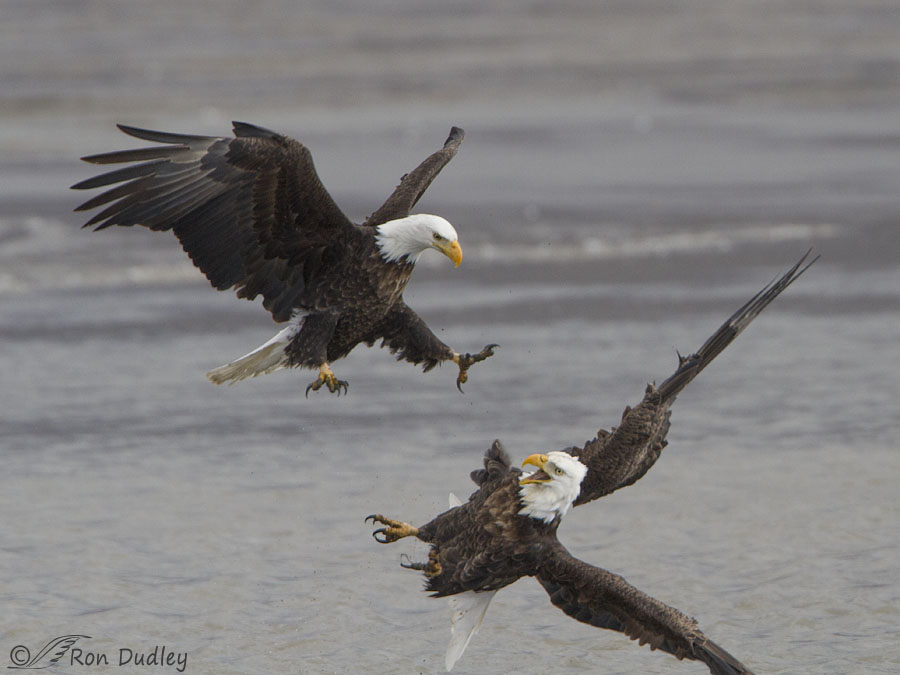
But Unit 1 wasn’t very conducive for good photography for me because I was nearly always there in the morning (long story as to why) and Unit 1 is to the east of the road so the eagles were usually backlit or in poor light from our winter cloudy weather and/or inversions. Lots of fighting went on out there but I usually spent my time elsewhere because of the poor light.
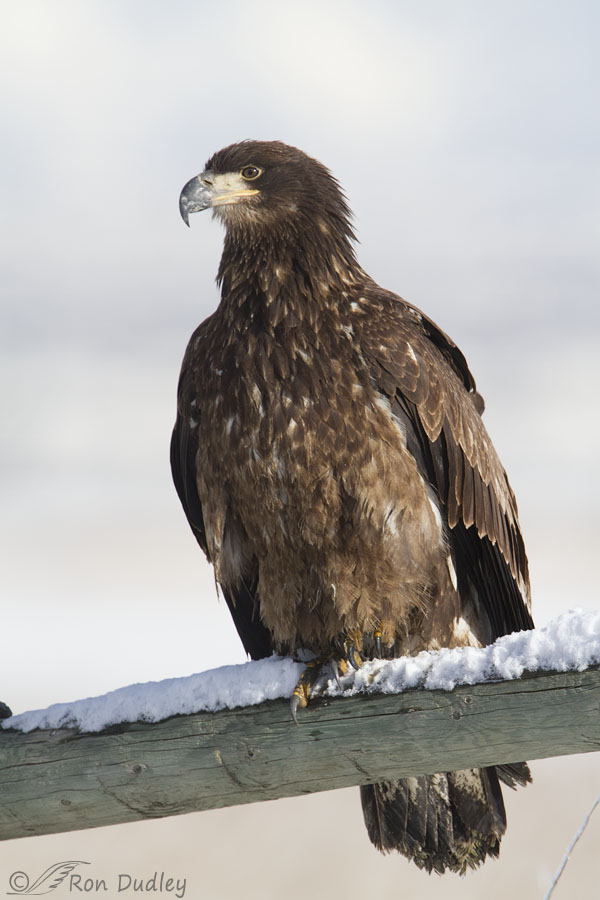
Occasionally there were opportunities elsewhere, including this amazingly “tame” juvenile. Most eagles on the refuge are skittish, especially early in the season, but this one almost seemed to crave human company. This bird landed right in front of me at a distance of less than two car lengths and I was on foot rather than in my pickup. The photo is full frame (uncropped) and I had to back further away to get all if ‘him’ in frame. Some folks were even closer than I was.
If I remember correctly he hung around and acted like this for several days and I’ve always wondered if he might have migrated down from the Homer, Alaska area where eagles were nearly hand-fed back in those days (maybe they still are).
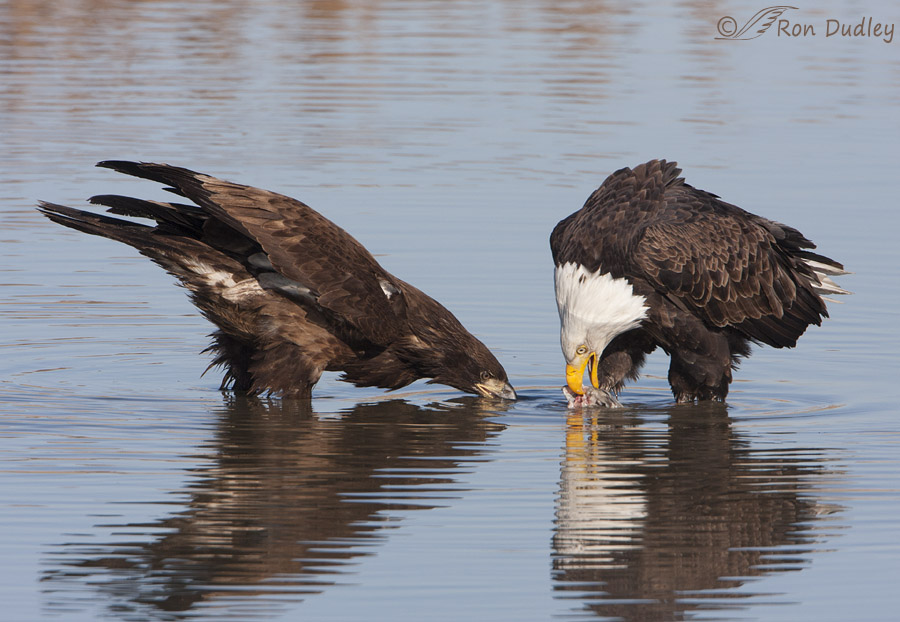
There were several excellent winters with eagles at Farmington after I took up bird photography but 2009 was truly spectacular. Refuge personnel had long used rotenone (a natural plant extract that robs fish of oxygen) to kill damaging and invasive carp on the refuge but in 2009 they did it upstream of the 4-way pond. Dead and dying carp would occasionally wash down into the shallow pond providing a feast for eagles and on clear mornings the light angle on the pond was just about perfect for photography!
I was as happy as a pig in poop and for some of January and a large part of February I just about wore out my camera on eagles. Here a particularly audacious sub-adult is attempting to pilfer some of what’s left of an adult’s fish meal. The adult wasn’t happy about the intrusion but no actual fight broke out.
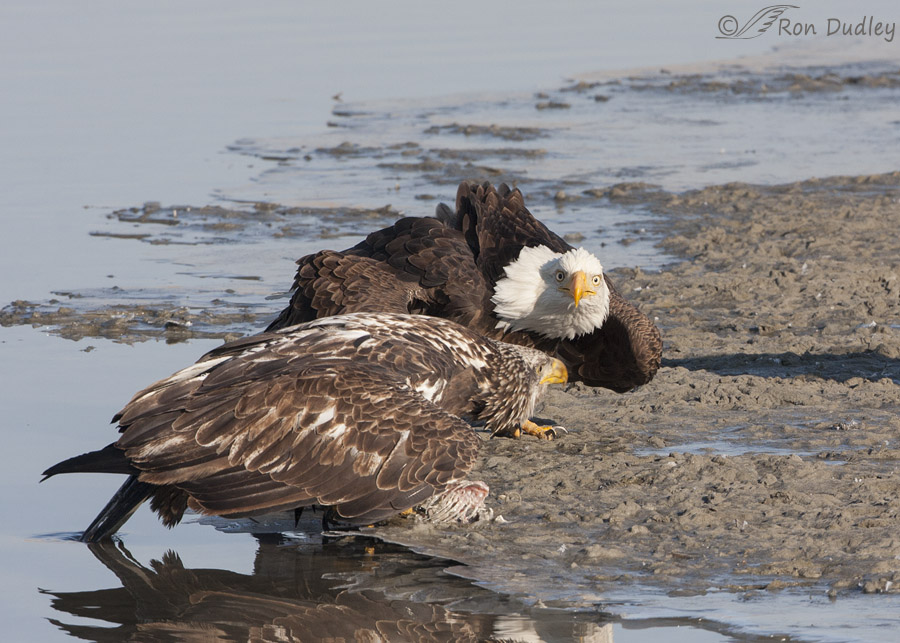
But they often did. Here the tables are turned and the adult wants the sub-adult’s fish. Talk about a dog, coyote or wolf raising its hackles, look at the “hackles” on that aggressive adult.
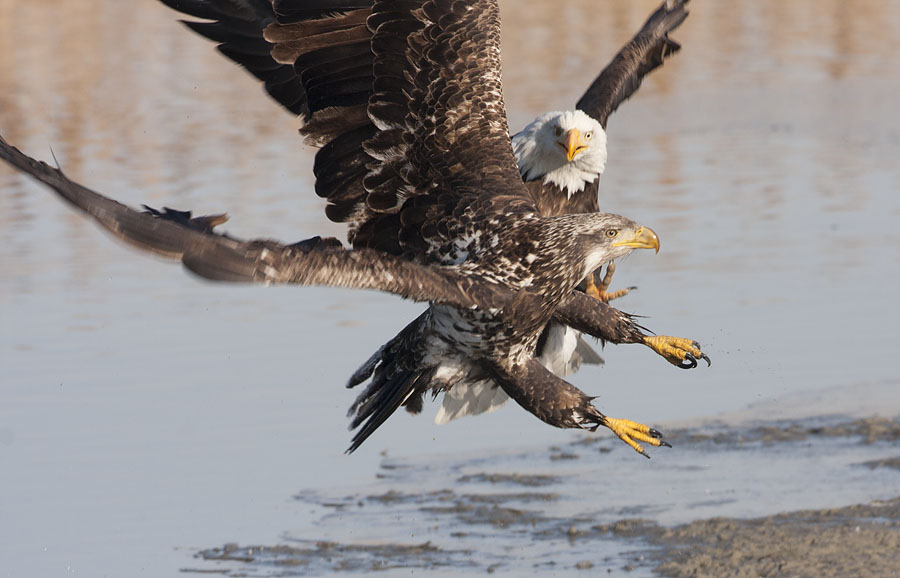
It didn’t turn out well for the younger and less fight-experienced eagle who quickly vamoosed.
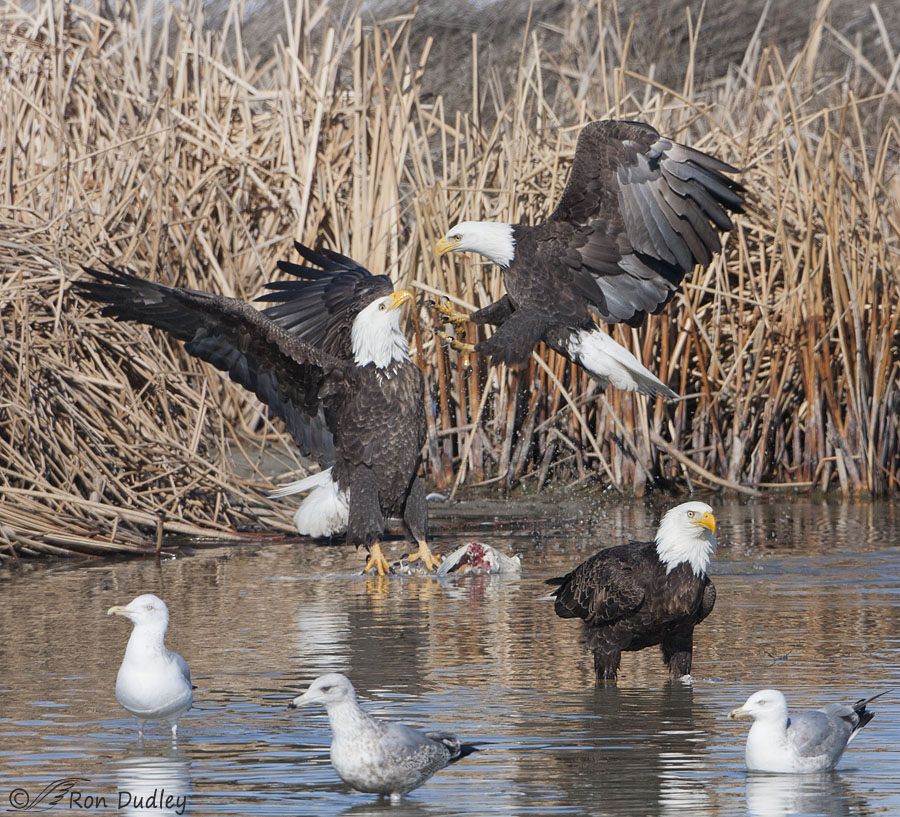
When fights broke out it was often difficult to keep the opportunistic gulls out of the photos. Thankfully, coots didn’t dare be in the vicinity.
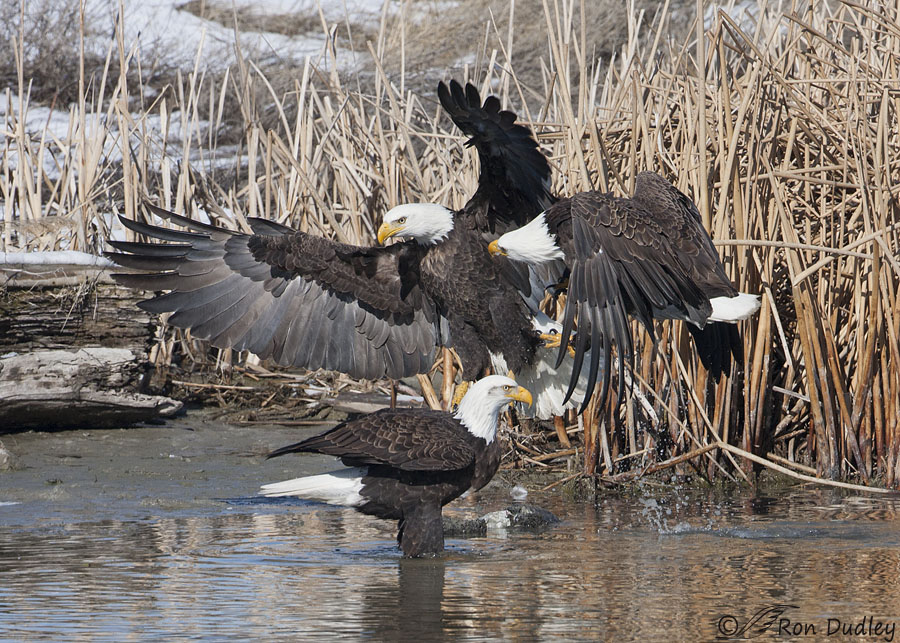
At times I was spraying my lens all over the place, trying to catch a fight here, an eagle taking off over there or…
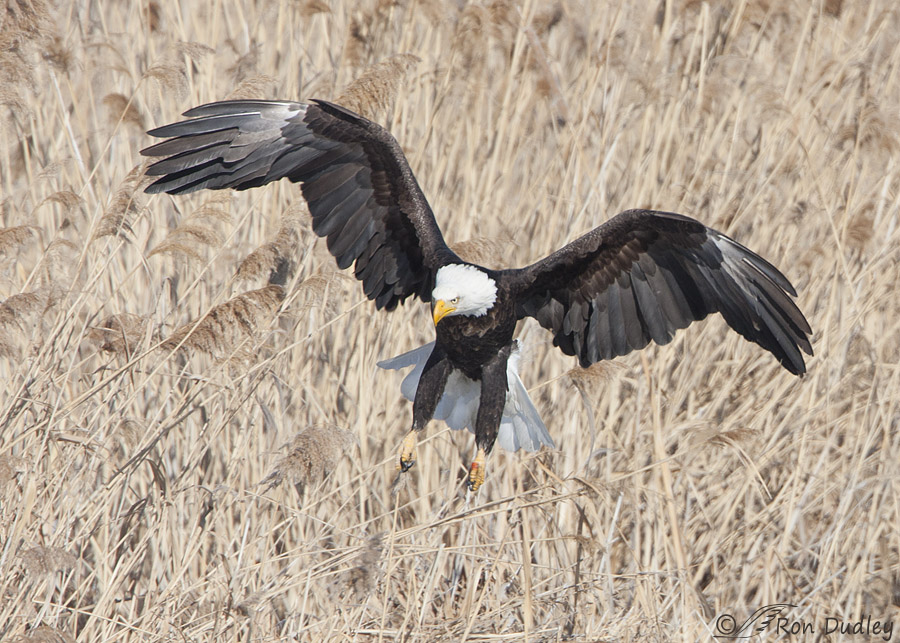
a bird coming in to land on the pond. It was a perfect training ground for the novice bird photographer that I was and I tried to make the most of it. It was sink or swim.
For this shot I wish the phrags in the background weren’t so bright but I think it’s a neat flight pose.
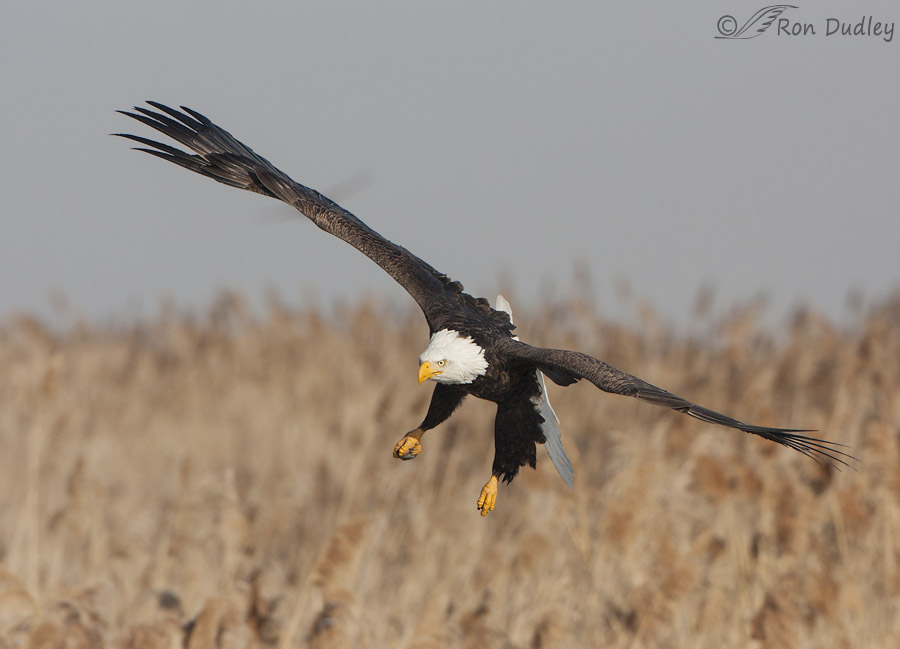
This isn’t a great shot but I stumbled upon it while preparing this post and I was struck by the extreme angle of the eagle’s tail so I decided to include it. I’d never noticed it before – another bonus from resurrecting these old photos.
What I’ve been doing so far is trying to give readers a feeling for how spectacular those early days were both for photographers and for eagles. Bald Eagles were obviously thriving on the refuge during winter and so were photographers, birders and nature lovers.
It was good times for all concerned.
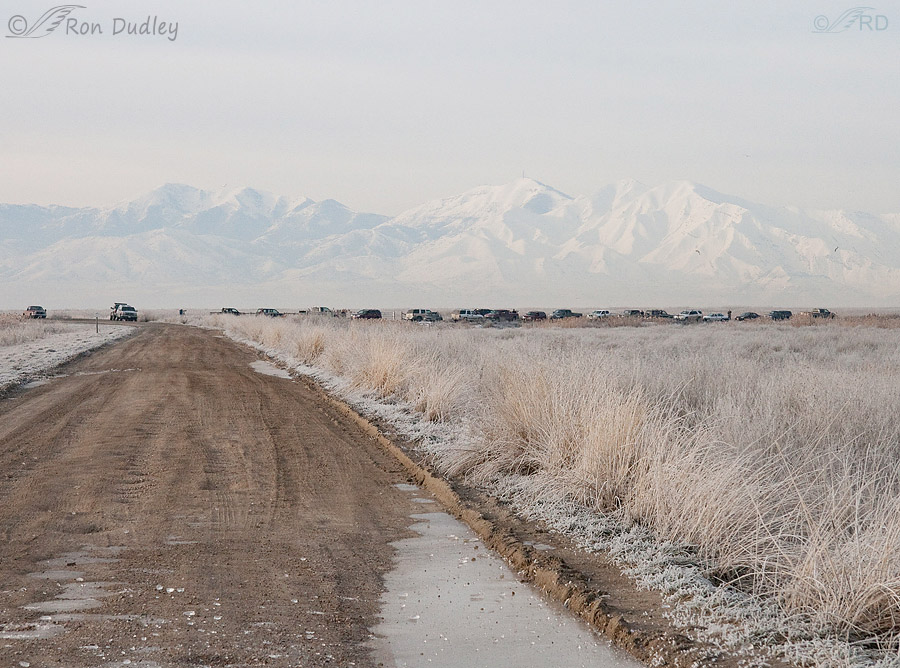
But eventually in 2009 word got out to bird photographers about what was going on at the 4-way pond and then the circus began. This photo was taken before sunrise – all those vehicles belong to photographers (not hunters, hunting season was over) parked next to the pond as they were waiting for sunrise and for the eagles to come in after fish. Even before the big crowds like this arrived later in February I remember having to be at the pond when it was still pitch dark in order to get a decent spot in the “shooting grounds”. Sitting there in the dark and freezing cold (notice the ice on the road), much of the time with your engine turned off and having no heat, was miserable but worth it.
Many of those vehicles are from out-of-state – especially Colorado, New Mexico and Arizona. Word really got out.
An issue with me at the time was baiting. At some point I learned that several of the photographers at the 4-way had been baiting eagles by moving dead fish to more photogenic locations with better light. So in extreme frustration over the baiting and the crowded conditions I started avoiding the 4-way altogether. Where I stopped on the road to take this photo is where I usually turned around and headed back north.
By then things started to really deteriorate for both photographers and for eagles on a variety of fronts. Notice in this photo that some of the photographers are out of their vehicles. When that happened it often created tension in the otherwise amicable group because it could scare eagles off or prevent them from coming in – they were much less wary of vehicles than they were of humans on foot.
One of the veteran bird photographers was particularly aggressive and obnoxious in his reactions to such behaviors that were usually innocent and always perfectly legal so the tensions mounted.
By February of 2010 “someone” placed these signs in the parking area as you approached the 4-way. The signs were meant mostly for non-photographer bird and nature lovers who were coming to the refuge in droves to view the eagles and most of them had no concept of the accepted etiquette of not getting out of your vehicles when eagles were around. It’s an understatement to say that refuge managers were unhappy about the signs and the territoriality that was developing so the signs were quickly removed.
Somewhere in this time frame word got out to state politicians that Utah was gaining national notoriety for their wintering eagles so “Eagle Days” was officially instituted at various wetlands and refuges in the northern part of the state. In this photographer’s opinion their motivation for doing so was largely financial and political, though state employees tried valiantly to get all the educational and environmental mileage out of it they possibly could.
Soon state officials with potential tourist dollars in their eyes put so much pressure on Utah DNR to promote Eagle Days that they started trucking in loads of dead carp from their control efforts at Utah Lake to the south and dumping them by the tons along the shore of Unit 1 at Farmington in a deliberate effort to bait even more Bald Eagles and tourists in. It was an unnatural, unsightly and eventually stinky situation that lasted for several years. I avoided Farmington more and more as time went by and when I did go I didn’t photograph the carp piles so I can’t document them with photos.
Then in early December of 2013 eagles started dying in northern Utah by the dozens. Eventually 27 dead eagles were found and others died in rehab – who knows how many carcasses were never found. For weeks no one could figure out what was causing the deaths though Avian Cholera and West Nile Virus were both suspected, among other potential causes. Eagle carcasses were sent to various labs and eventually it was confirmed that the eagles had died from West Nile Virus.
Mosquitos are the vector of WNV and it is believed that the eagles were being infected by eating dead, infected Eared Grebes that migrate through northern Utah in huge numbers. But there was concern that the illness might be passed from eagle to eagle because of their dense concentration in places like Farmington so carp dumping was stopped. Better late than never in my opinion.
Although there’s no evidence I’m aware of that carp dumping caused or facilitated the spread of WNV among eagles their numbers at Farmington in winter have never returned to anywhere near those of the “glory days”. Eagles still come to Farmington in winter but they’re usually few and far between and difficult to impossible to approach. I haven’t taken a decent eagle photo at Farmington in the last several years.
And maybe that’s as it should be, although I sure do miss the glory days when non-baited eagles visited Farmington in huge numbers, every Tom, Dick and Harriet didn’t have a huge, expensive lens and none of them had a chip on their shoulder.
Ron


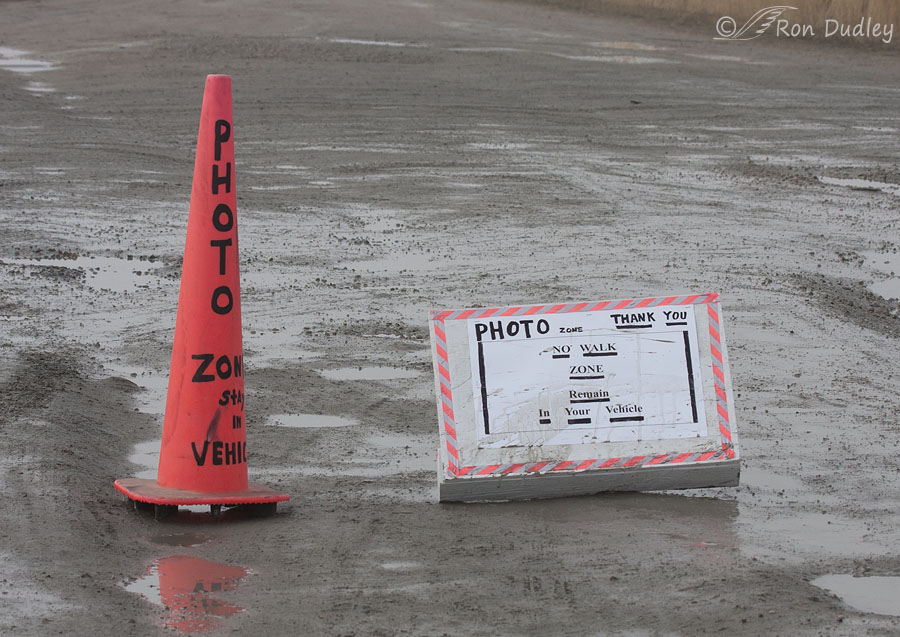
Excellent article Ron, I learned a lot from it. You were lucky to have experienced Farmington Bay before it changed the way it went. That must be very hard to have seen it go through this transition. I visited the winter eagles for a couple of years, I think back in 2012 and 2013 and it was amazing. I found the photographers there to be pretty friendly and worked together to keep people in their vehicles. One year I brought a know-it-all scientist from Los Alamos who behaved in the most embarrassing way, he upset a few local photographers by pushing his way right in front of their vehicle where they had been patiently waiting. Greed, selflessness, and being a one-man self-licking ice cream cone, unfortunately, does promote die off in the human population like West Nile Virus does in the bird population ;-).
I hope that Farmington Bay improves for the wildlife. It is a gem of a refuge, located so close to a major population center. Often that is a hard thing to manage because every human stakeholder group wants their share and access. Some refuges exist that are closed completely to the public. Since the Great Salt Lake is so important to the migratory birds in North America I hope that refuges like Farmington Bay and Bear River NWR are able to sustain themselves with the livelihood of the wildlife being the first priority.
Thanks for the history lesson and amazing photos. It is good to remind ourselves of how natural places are when they are managed well.
“a one-man self-licking ice cream cone”
I know that type too, Ed. In fact I may (or may not) remember the guy you’re referring to. Thank you.
Great post Ron! As a long time “marsh rat” at Farmington Bay, you brought back some great memories, to me. In fact, my truck is in the early morning photo you posted., and I recognize many of the others. I think most of the photographers were respectful of the eagles and of each other. Of course, there were a couple of notable exceptions. I had forgotten about the “no walking” sign, and it gave me a chuckle. It is always hard to convince people of the early days of the Eagle Tree with the dozens of eagles that would gather there. I also remember that juvenile (and have many photos) that had no fear of humans. Thanks for sharing. Joe.
Thanks, Joe. And I agree, the vast majority of the photographers were respectful of both the eagles and the other photographers. Overall I think we’re a great bunch. But one or two exceptions can sure change the experience for others and that’s unfortunate.
I wish I’d taken photos of that “eagle tree” back in the 70’s and early 80’s so I could remember what it looked like while it was still alive. I assume it died in the floods of 83.
Wonderful post with so much info about the entire area. I have a personal interest now since my daughter is volunteering at the Eccles Education Center. She feel in love with it and is very excited with the whole experience and her work with Bill Fenimore.
I think it’s great that your daughter is volunteering there, Betty. Billy’s a great guy and you know how I feel about the Wildlife Center.
I’m REALLY late to the party. So many potential comments running through my mind right now. Amazing shots and thank you for sharing them.
Better late than never, Marty. Thanks.
Super late today on commenting.
Had tears in my eyes at the beginning of this post. Breathtaking photos at the beginning… to the end, stupid people.
The Bald eagle whether it be pictures or the beautiful pair I have the privilege of seeing will always be appreciated. My Favorite ❤️
If this was the “gem” you were teasing us about, Thank you Ron
Thanks, Diana. I was referring to a variety of surprise gems I rediscovered when I reviewed these older eagle photos again. These are only some of them.
Love all the photos and the recap of eagle history at Farmington. I miss seeing so many there. They really covered the landscape from the trees around the office building to being almost a carpet on the ice. Thanks for crediting me with your reintroduction to Farmington. I had just been a long time volunteer there and given that privilege. You more than paid me back by teaching a bird photography workshop with Mia for GSL Audubon. You got me hooked on bird photography that I enjoy tremendously to this day.
Deedee, I hate to think of how long it might have taken me to rediscover Farmington without your assistance that day. You really opened my eyes. Thanks very much once again. And for putting up with all of my teasing on those overnight field trips with the museum’s Jr. Science Academy.
Oh, the stories we could tell… 🙂
“Oh, the stories we could tell… 🙂”
I smell blog fodder! 😉
Amazing (and sad) journey through time. Thank you so much. And, I think the eagle with the sideways tail is an amazing shot! So there. 😀
Thanks, Arwen. I like it too, that’s why I included it even though I don’t think it’s “great” in the usual sense.
Ron, the photos in this blog are spectacular. The stories about the rude and obnoxious people are discouraging. Some people are just ruinous.
Thank you for sharing these photos and story. My eyes have been opened wider.
Thanks, Alice.
I was late to the party and only went out a few times during the baiting period (along with Tom, Dick and Harriette). It was great to see so many eagles, easy to get some great photos, and awful to deal with so many inconsiderate and obnoxious photographers. I went out to the circus infrequently for 2 years and then, thankfully, they stopped it. Thanks for the wonderful history lesson and your observations. I appreciate your patience, perseverance, hard work, knowledge, wit, and stunning photography!
Thanks very much, Larry. Yes, it was difficult to endure much of what was going on out there, especially in late February of 2009, but some other times too.
Those glory days were just that. Absolutely glorious.
What incredible scenes to have in your heart and mind – and to have captured on camera as an additional bonus.
And a huge sigh at the greediness (of our species) which wanted to capitalise on that magic. As I have often said, I am frequently ashamed of our species.
So am I, EC. Thank you.
Besides the absence of dead carp, are warmer winters in SLC another factor in fewer Bald Eagles in general ?
I strongly believe so, John. But with lack of concrete evidence of that I decided to avoid suggesting the possibility.
Lovely photos and interesting story. I missed the eagle hay-days at the bay. I was busy in wildlife rehab during that time. When I wasn’t teaching I was living in a shack called Ogden Natures Center’s Rehab and it was literally a shack no heat and no running water. I have photos I can share with you if you’d like. Wildlife Rehabilitation Center of Northern Utah broke off from Ogden Nature Center in May 2009 and formed it own non-profit in August of the same year. Boy was that intensive and stressful work, but the final product was worth it all!
I grew up roaming the dikes of Farmington Bay, 1969-84 before all the gates and roads,through years of high water and birds to match the everglades. During the floods of 1983 the Great Salt Lake shore returned to the edge of I-15 along the Farmington, Centerville area. If your readers are interested maybe you can give a past history of how it started and ran into disrepair, flooded and then built up again to be fenced in by Legacy Highway and development. The only way to get to my favorite areas are by walking. I am sad that they are now closed most of the year. I don’t like to walk the areas during hunting season. The duck hunters don’t like you spooking the game, they are snarlier than photographers and armed!
“they are snarlier than photographers and armed”
Good point, April! And based on my experiences with one of the photographers I became far too familiar with that’s pretty damned snarly.
Some of the articles I read mentioned Buz at WRCNU and all the eagles that you folks got into rehab.
I assume that the “eagle tree” died in the floods pf 83. One of my readers posted a photo on FB of the eagle tree snag taken in 2005. I couldn’t believe how much larger it was just a few years before. I counted almost 50 eagles in the tree in his photo. Now it’s only a single stick and it’s almost down.
The Bald Eagle deaths of 2013 was very disheartening to WRCNU. I did not work with the eagles directly, but the eagles all had neurological symptoms, tremors, difficulty standing and seizures. All these symptoms present with numerous neurological diseases including lead poisoning which is common in eagles. It was not until the first necropsy results returned from the national lab that West Nile was diagnosed. West Nile was unheard of in winter time. There is no cure for West Nile, it was fatal in the eagles cases.
Beautiful photos! It is heartwarming to see eagles in multiples like that. The photo of the juvie trying to share the food is great. You can definitely read the adults face in that one! A couple of miles from me is the Fox River. There is a paper mill bordering it so the water does not freeze in that vicinity. There are dozens of eagles that winter in the area because of prime fishing in the river for them. Last winter I counted 23 in the big old cottonwood like the tree you pictured. The paper mill does not allow anyone to park on the road bordering their property and the side opposite has a chain link fence a mere 4′ from the road so not conducive to photographers; the eagles are commonplace for the locals so eagles are not bothered. Nothing bothers me more than baiting…any animal /bird for that matter…just have no tolerance for it; hoards of photographers fall in that category too.
“Nothing bothers me more than baiting”
I couldn’t agree more, Kathy. Beyond the potential dangers the practice has for birds and wildlife I believe baiting is nothing short of disrespectful. And then there’s the dishonesty usually involved because virtually no one discloses their baiting to those who view their photos.
Thanks for the lesson, Ron. Sadly, you can love something to death. As we see in our national parks as here in this WMA.
Exactly, Art. I noticed that the Tribune had an article on what we’re doing to our national parks just yesterday. For years I’ve spent large parts of my summers in southwest Montana quite close to Yellowstone but I haven’t actually entered the park for about 10 years now and don’t plan on doing so again. For me it’s simply been ruined.
I’m having to scrape my jaw off the floor, reading this tale and viewing these photos; thank you sharing this history
I guess it was kind of hard to believe. Even I look back and wonder, did all that really happen? Thanks, Nicky.
Great post, and what a memory before the hoards came!
Don’t blame you, would have stayed clear as well. Although I was a teacher for 36 years I have never liked crowds, especially ignorant individuals who care only about themselves and less about wildlife!
Tough job for park officials.
Thanks, Dick. Yes, refuge managers had some headaches, that’s for sure. They had to tell at least one photographer that he was no longer welcome at the refuge.
Martha certainly said it all……..especially #’s 3 and 4……….they are ruining almost everything I ever held dear. I ‘m at least glad that you were able to establish visual proof that the
“glory days” weren’t an overwrought , sentimental delusion…..
Thanks, Kristine. They were certainly no delusion…
1. Same old story. Selfish, self-centered people who have not been taught their responsibilities to society nor to land and wildlife.
2. Greedy bureaucrats commercializing everything.
3. Scrum of wildlife photographers trying to make a living in a crowded field.
4. Too many people.
5. Race to the bottom. Conflicting demands. Weaponizing money, land, photography.
6. I have had people follow me to try to find my sites. I have told at least three people I will never take anyone with me.
7. Rotenone thins blood, is taken up in organs, accumulating up the food chain. You would need to ask state fish and game if they took samples from the eagles to test for rotenone in organs, lungs, flesh.
Yup, same old story, Martha.
Yes, I’ve researched rotenone quite extensively.
I have yet to get a single picture of a Bald Eagle; however, I have seen one or two. I was stunned by some of those pictures. Great job! Thanks for sharing!
Thank you, Aidan.
Ron, I really enjoyed this post and all the info documenting Eagles in this area. I live in southern NY and don’t get to see Eagle concentrations like that very often. Always a treat when I see 20 or more migrating through our area. I have a nesting pair near me that I monitor and photograph for the N Y DEC. Fortunately, I rarely see anyone near the nest which is 30 yds from a busy road, overlooking a reservoir. You might like to know that my favorite shot of all you posted is the one you said was not a good shot. Remember, personal preference can vary a great deal. Don’t be so sure a picture doesn’t have merit, some of us might disagree.
Thanks for a great morning looking at Eagle pictures.
Thanks, Reid. And I agree – as I’ve often said on my blog regarding photo preferences “it depends on personal tastes”.
Love those photos and would have loved to be there .. sorry some photographers aren’t ethical . Picture means more than bird .. but man those pictures are to die for .. ( me .. not eagles). How come they didn’t come back so ?? What caused them to stop coming?. The West Nile virus was pretty bad over here too but it’s been one now for several years ? You should go to Alaska.. there are still places with huge amt of eagles …
I don’t think anyone knows for sure why their winter numbers have been so diminished. There are many possibilities. Thanks, Marina.
Wow Ron, amazing photos and story. I guess I should be very happy that we generally have no more than two eagle pairs in our entire area. Photographers are few and far between. That circus atmosphere would have been a real turn off although many would be willing to do it in order to get some great eagle photos. Thanks for sharing this.
Everett Sanborn, Prescott AZ
Thanks, Everett. I hope your eagles aren’t “discovered”.
Great shots, Ron! Had never thought of “raised hackles” on a bird! 😉 And VERY interesting/disturbing commentary on the the history of the area as far as photographing the Bald Eagles is concerned. Humans, as a species, just can’t leave well enough alone………:(
I don’t see “raised hackles” on birds very often but this was one pissed off adult. And you’re right, if humans CAN screw something up they almost invariably will. Thanks, Judy.